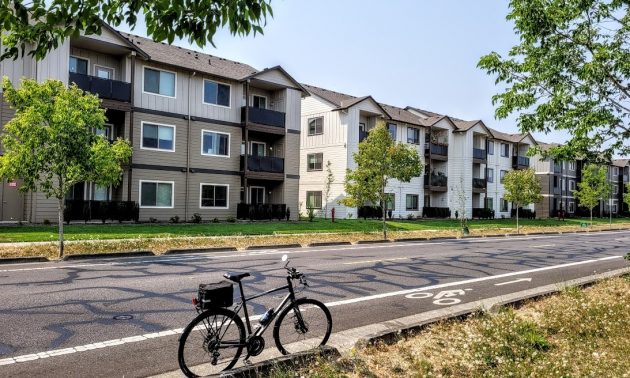
New apartments like these on Timber Ridge Street N.E. have added to Albany’s population.
The population of Albany grew a little faster in the last few years than the official estimates had shown. That’s one of the conclusions to be drawn from the local results of the 2020 U.S. Census.
I had not heard much about the local population count completed last year. So I took a look at what the government has made available online.
As of April 1, 2020, the date of the census, the number of Albany inhabitants was 56,472. That’s about 1,500 more than was posted by the Population Research Center at Portland State, which is in charge of making annual estimates for the distribution of state liquor earnings and tax revenues.
In Corvallis, the census counted 59,922. That too was above the estimate from Portland State, but only by 192.
During the decade since the last census, Albany grew a little faster than Corvallis. Albany added 6,314 people from 2010 to 2020, compared to 5,460 in Corvallis.
You can find the census results for Oregon cities and counties on the Internet here. There is lots of stuff there, from the age and sex of our population to race and Hispanic origin, housing, education, and much more. If you care about all that you can look it up.
As for sheer numbers of people, the research center at Portland State projects that Albany may have between 72,000 and 78,000 people by 2040, along with about 9,000 additional housing units.
If they’re right, think what that will mean for trying to get across town on a Friday afternoon. (hh)


The federal government’s census adequately covers identity in terms of skin color.
For example, Albany’s population is broken down into white, black, American Indian & Alaska Native, Asian, Native Hawaiian & Pacific Islander, and Hispanic or Latino.
It is helpful to know the size of the polarized race units that are competing against each other in the battle for political favor and control.
But we should demand that the census collect additional identity data beyond skin color.
The census should also require that we provide the authentic, true identity we feel from within. For example, Facebook allows at least 58 options for self-identification in this regard. The census bureau should do the same.
To not acknowledge, and perhaps reject, someone else’s sense of self-identification is an act of emotional violence. The federal government should not oppress us in this way.
Yesterday I was feeling that “puppyself” was an accurate neopronoun for me. But that option is not on the Facebook list of approved identities.
So using the Facebook list, I’m feeling that “other” is my true identity. The census record should reflect both my whiteness and my inner “other” feeling of self-identification.
Many of those groups in the census catagories regard themselves as white.
Many Latinos I have known all my life consider themselves white.
What does it really matter in the long run?
If it is really important let’s just have a mixed race catagory.
After all isn’t America “The Melting Pot”.
Without reliable census data on race it becomes difficult for bureaucrats and activists to track whether people of color are receiving equitable outcomes in housing, voting, employment and education.
As the U.S. population becomes more diverse, advancing justice and equity along the color line becomes more important than ever.
Good grief Gordon, you say:
“The census should also require that we provide the authentic, true identity we feel from within.”
Each person is freed to fill it out anyway they want. They do it in the privacy of their home.
What a putz.
Evidently the editing standard is arbitrary when it comes to name calling and personal attacks on this blog. Hasso, please be more consistent.
I believe a “putz” is defined as “Someone who is unable to recognize sarcasm and or humor”
“””… Albany may have between 72,000 and 78,000 people by 2040, along with about 9,000 additional housing units.
If they’re right, think what that will mean for trying to get across town on a Friday afternoon.”””
50 minutes by car, 30 minutes by bike ;-)
It’s absolutely crazy to me that it seems like, Albany keeps building homes/apartments in result bringing so so sooo many more people to Albany..YET we have the same restaurants?? You go to Salem and there is plaza after plaza filled with little food places. Is it because whoever is on the committee is saying No??? I mean come on Albany if you keep building all of these subdivisions then accommodate people when they are looking to take their Families to dinner instead of waiting in line fore 30+ minutes at Applebee’s or Red Robin just to get cold blan food. We need more variety!!